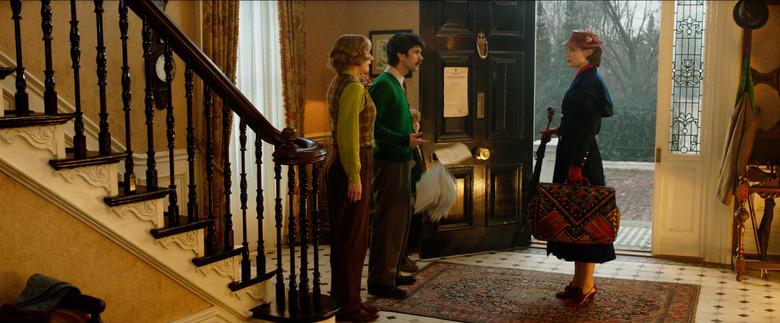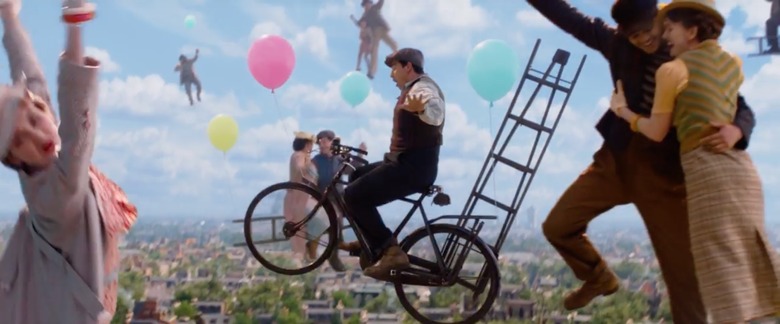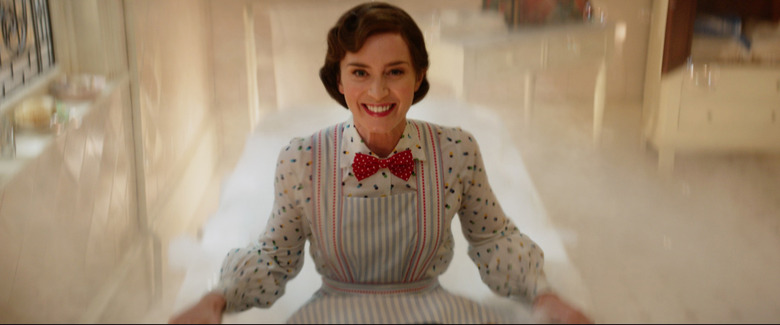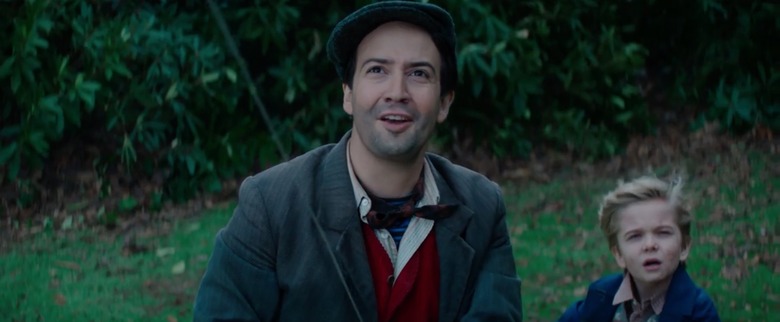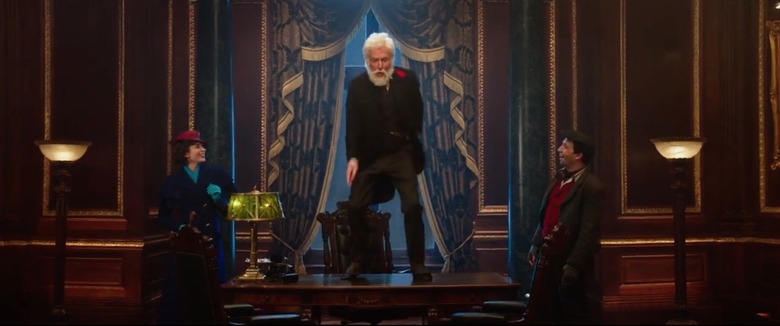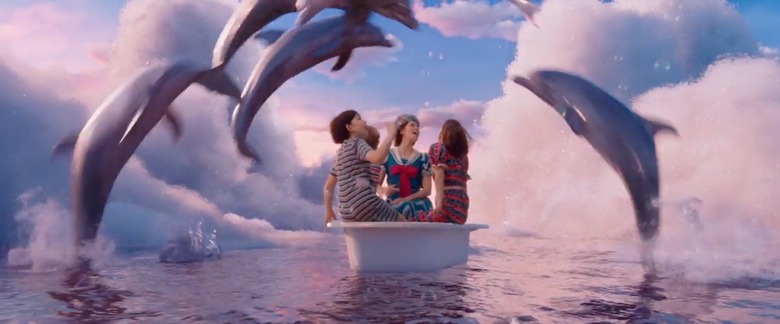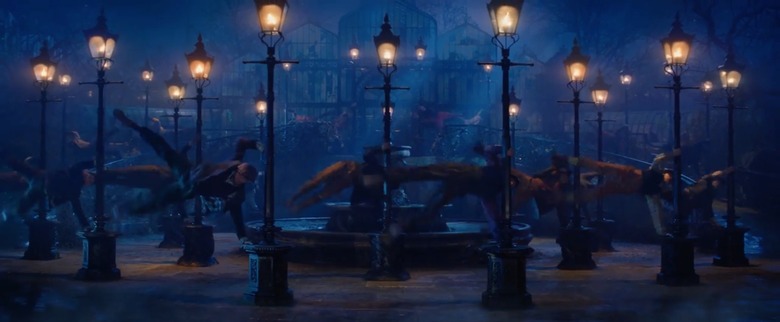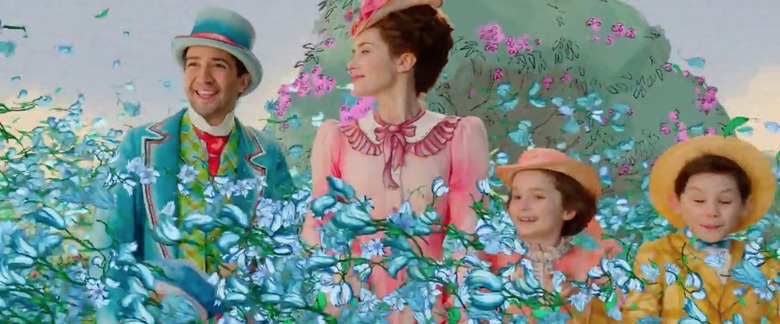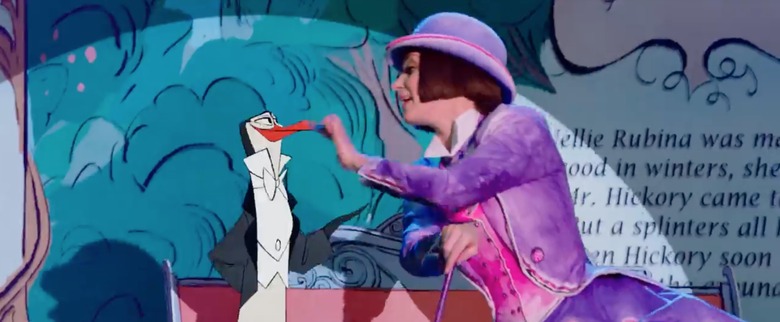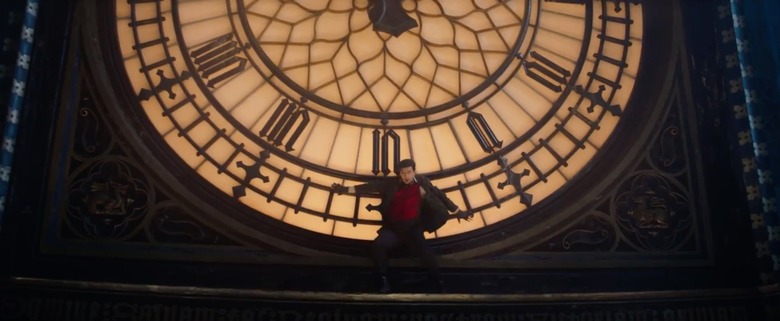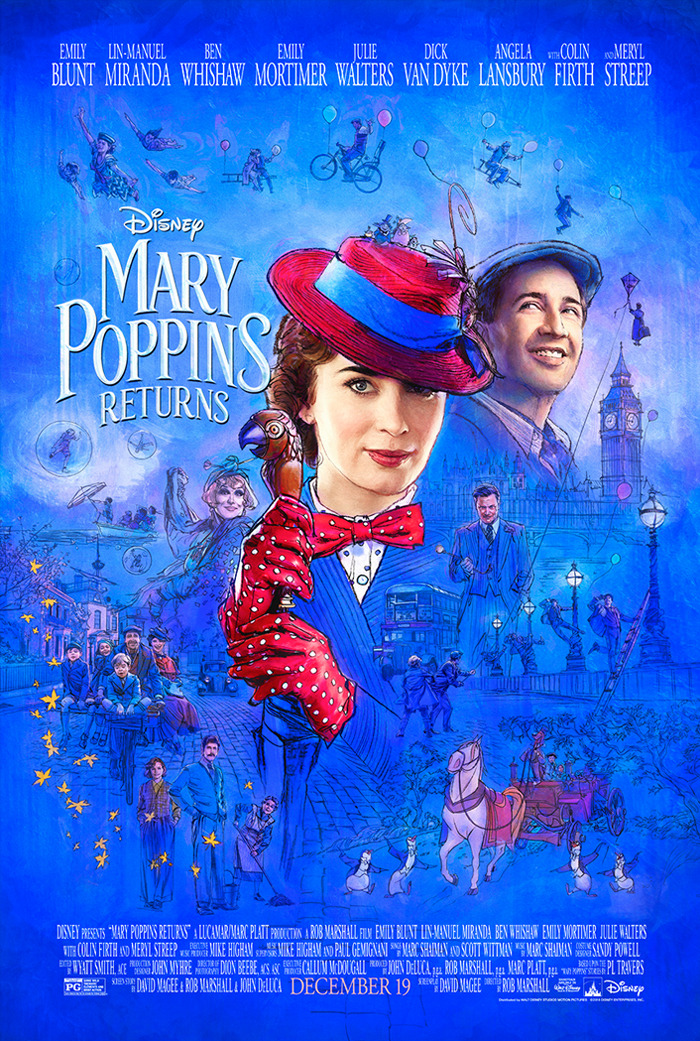'Mary Poppins Returns': Every Supercalifragilistic Detail We Learned On The Set Of Rob Marshall's Sequel To The Disney Classic [Set Visit Report]
Last year, I flew across the Atlantic Ocean to visit London, England. Specifically, I visited London, England so I could visit a recreation of London, England on a series of sound stages at Shepperton Studios. But this wasn't just any recreation of London. This was the London of Mary Poppins Returns, a London full of magic and whimsy and yes, lots and lots of music.
A direct sequel to the 1964 original, Mary Poppins Returns stars Emily Blunt as the magical nanny and Lin-Manuel Miranda as Jack, her new partner-in-song-and-dance. Rob Marshall, the director of Chicago and Into the Woods, is behind the camera and everything we saw on set suggests that this movie should be a delight.
This is Very Much a Sequel to the 1964 Original
Despite the new cast (and despite being made over 50 years later), Mary Poppins Returns is very much a direct sequel to the original Mary Poppins. It's still set on Cherry Street Lane. It still focuses on the Banks family. And the magical nanny of the title is the same magical nanny Julie Andrews played all the way back in 1964.
Producer Marc Platt laid out the basic plot structure for us:
Our story is, as I said, set in the 1930s. Michael Banks, the young boy from the original film, is now a father of a family and he's living in Cherry Tree Lane in the house and he has children. There's been a loss in the family, and so there's a need for Mary Poppins to come back into their world and to the world of these new children, to the world of Michael Banks and his sister Jane, and see if she can bring joy back into their lives.
And while Michael Banks is now played by Ben Whishaw and Jane Banks is now played by Emily Mortimer, they are very much the same characters we first met as young children so very long ago. During our set visit, we saw that old suffragette sash once worn by the Banks children's mother, still acting as a kite tail. As a wonderful nod to their politically progressive mother, grown-up Emily is a union organizer. Of course, Michael has followed in his father's footsteps and works as a banker under William Weatherall Wilkins (Colin Firth), the villain of the film.
The production team took this being a sequel very seriously. We saw concept art and models that showcased an exact recreation of the sets from the original movie and were even able to explore the Banks' house, a surreal experience for anyone acquainted with the original film. Production designer John Myhre explained the process of building a mostly practical Cherry Tree Lane (although a fair amount of CGI will be used to bring everything to life):
The film opens up in the winter time and then at the end of all the Mary Poppins magic, spring comes magically overnight to London. So we needed a street that could look like this illustration here with all the bare trees and kind of grey and then magically, suddenly burst out in cherry blossom. So we built trees that were 30 feet tall that could one day be winter trees and then over the course of a two-week period where we pulled all the limbs out and put in new limbs, 900,000 to 1 million cherry blossoms had to be put on by hand, so that was the reason we ended up using this as something that we built here on the stage. Most of the other streets, almost all the other streets are going to be real.
But what about the Banks family's neighbors? Yes, Admiral Boom is still alive and yes, he's back in this movie, albeit in a naval-themed wheelchair.
While the story in Mary Poppins Returns is new, the basic structure will be familiar: Mary arrives and goes on a number of magical adventures with the (new) Banks kids. And Emily Blunt, who plays the new Mary, had nothing but praise for her young co-stars:
I'll start with the kids because they are my main compadres on this. When someone says, "Hey, you want to take on Mary Poppins?" I'm like, "Yeah!" And then you realize that all of your scenes are with children. Actually, our kids are particularly brilliant and it's been wonderful and quite moving to see them grow up in this experience and become real pros. Even Joel [Dawson] who wasn't even eight when we started rehearsing, he was really young and hadn't done anything before and having to be told, "This is a mark, you have to take your mark. You have to look here because of continuity." Can you imagine hearing of that as a kid? Because he is such a bright boy, he has grasped it and he really is that character. So he has got this vibrancy to him as a person, and he is bonkers as well, he is absolutely mad. This boy's imagination is incredible.
But It is Also an Adaptation of the Other Books
While Mary Poppins Returns frequently nods to the original film and exists in the same continuity, the production was not shy about utilizing the work of author P.L. Travers to fill out the story and the cast. As Platt explained:
We went right to the source, we went to P.L. Travers. And it turns out that P.L. Travers wrote eight books, and the original film really capitalizes on only one of the books. And what we found in her books was really a treasure trove of new characters and episodes. And we realized that we could bring the sequel, our own version and our own story, an original story of Mary Poppins all these years later in a very exciting way, but that we could draw upon the original source which is P.L. Travers.
The result is a remix of sorts, a "greatest hits" of Travers' writing that borrows bits from across her entire work as everyone saw fit. Platt elaborated:
You know, we took from a number of them, actually. Because the books are in some ways a collection of episodes and adventures, and so we plucked some from various books and drew upon a number of them actually.
Fans of Travers' work may be thrilled to know that the legendary Angela Lansbury is playing The Balloon Lady in Mary Poppins Returns. But regular ol' movie fans will be excited by the mere presence of the great Meryl Streep. The three-time Oscar winner plays Topsy, a "fix-it shop owner" whose store is filled with assorted kick-knacks and items. We were able to tour this set and it quickly became apparent that this was no ordinary shop – everything was upside down. Literally. As Myhre explained as we navigated the surreal, wondrous, and entirely space:
The first Monday of every month, her entire house turns upside down. So I was reading that we needed to have Mary and Jack and the kids interact with an upside down fix it shop that would have not hundreds of things in it, but thousands of thousands of maybe ten thousand things in it. So if you can come up and take a peek at the illustrations, the lower one shows this upside down room, so the ceiling with the chandeliers are all down and the floor with the carpets and pianos and everything being fixed is up high. So we first started looking at this, most people were saying, 'Well, we'll probably do this in CG. We'll probably shoot this in a big green-screen room.' But Rob and I said, No, let's actually build it. So we actually built a set that has thousands of things bolted to the ceiling and a set that Mary Poppins could look into that could have her looking down into the room...so she and the kids have to get into the room. So she steps on upside down shelves and walks across an upside down fireplace.
Of course, the set was built to be large enough for a big musical number.
Emily Blunt Was the First Choice for the New Mary Poppins
Emily Blunt is one of the finest actresses working today, capable of leading soapy mysteries, prestige dramas, and kick-ass science fiction action movies. Of course, she was also the leading lady in director Rob Marshall's big screen take on Into the Woods, which meant she was at the forefront of everyone's minds when it came time to find the new Mary Poppins. Marc Platt told us all about it, finding time to also praise her singing and dancing abilities:
When it came to casting, really, we could only think of one person to step into the shoes and to own the role of Mary Poppins and that was Emily Blunt, an actress who we've worked with on Into the Woods and most recently did Girl on the Train with her. She's not only a consummate actress, who possesses a tremendous craft as an actress, she sings beautifully. By the way, she dances magnificently, you'll see in the film, which was a big surprise. But she's also instantly authentic as the role of Mary Poppins. She's very related to it, she grew up in this world. And she has a way, and has found a way, to make the character her own. It's her own interpretation. And she's quite sublime in the role.
Of course, it is not lost on anyone that Mary Poppins has not aged a day in decades. Platt explained:
Mary's a character who lives outside time. She's magic. And so she is the one character who actually doesn't age. So she is as ever as we know her and as she will be forever, that character.
"It's very surreal to me being Mary Poppins," Blunt told us when we sat down with her. The fact that she's playing a legitimate icon is not lost on her:
Well, I think Mary Poppins as a character is so iconic, and I think the film, for me, and I think for most people, is one of those films that is sort of seared into people's memory, an emblem of their nostalgia in many ways. So I do remember it very fondly and took such a great comfort in it as a child, that was something that struck me of that person coming in and so capable and so magical, and just sweeping it all up and making it right. I took a lot of comfort in that as a child, so I think we are trying to, obviously, continue that now too with our film.
Blunt explained that she had to find her own take on the character, because just doing a Julie Andrews impersonation was not going to get the job done:
I feel that I just try to approach her as I would any other character and not be caught up in the white noise of, "Oh my God, you are Mary Poppins." I think that has been my main focus, is just to approach her calmly, as I would any other character, how I would play her, with what I have given on the page? I have not watched the originals since I saw it as a child, cause I... no one is going to outdo Julie Andrews. I think I just want to... this is just going to be my version her.
Meanwhile, costume designer Sandy Powell had to make sure the new Mary Poppins has a look that is instantly identifiable as...well, Mary Poppins. For her, it was all about nailing the silhouette:
So, the first thing to think about and probably the most daunting task was what Mary's arrival outfit is and the look that we're going to remember her for. So, thinking back to the original and what you notice most about the original look is the silhouette because that's what we all remember seeing is that little silhouette of her coming down with the umbrella.
Mary Poppins may be an immortal, supernatural nanny, but it's been decades since the first movie and fashions have changed. Powell noted that Mary has kept up with the latest trends and dresses accordingly:
And that was set in sort of an Edwardian period, or meant to be an Edwardian period with some 1960s thrown in, but um the coat was just above the ankle, sort of nipped-in at the waist with a hat and an umbrella. So I wanted to do something similar and actually 1934 is a period for women which is not a million miles away in shape because it's a longer longer hemline, much longer than a few years later in the 1930s toward the war when hemlines rose up toward the knee.
Lin-Manuel Miranda's Miranda is Burt's Young Protege
In the original movie, Mary and the Banks kids were frequently joined on their adventures by Burt, a cockney chimney sweep who was very familiar with the magical nanny and was no stranger to her unique charms and abilities. In the sequel, Burt has been replaced by Jack, a lamplighter who traverses London on bicycle, bringing light to the city streets.
But fans shouldn't see this as a slight. After all, Jack is played by Tony, Grammy, and Emmy winner Lin-Manuel Miranda, best known for writing and starring in Broadway's Hamilton. That by itself should be enough to win over just about everyone. But as Platt explains, Jack shares a direct connection to good ol' Burt:
Jack in our film is an adult protégé of the original character Burt. But he's not a chimney sweep, he's a leerie. And back in the day the leeries were those who rode around on bicycles with ladders and climbed up to the lamp posts and lit the street lamps on the streets of London, and then doused them in the morning when the dawn would rise. And to play that role we got the exciting performer, most notable from Hamilton, Lin-Manuel Miranda. Wonderful song and dance man, wonderful actor, which is what he's doing in this film. And he inhabits the role of Jack and creates a wholly original character, playing this leerie. And he gets to do all the things that you want to see Lin do. He gets to be charismatic. He gets to bring light into the world. He sings. He dances. And, believe it or not, 1934 music hall style he even gets to do a little rap. It's quite extraordinary.
Yes, Lin-Manuel Miranda will get to rap in the new Mary Poppins movie. What an age we live in.
Miranda himself, an old school musical fanboy if there ever was one, could barely contain his enthusiasm for the project. That's appropriate, because as Miranda explains it, his Jack is very much a Mary Poppins fanboy:
Yeah, you know, Jack is a lamp-lighter. He apprenticed under Burt from the original films so he knows all about Mary. He knows that Mary shows up and stuff's going to happen and cool adventures will be had. So it's really nice to play the Burt position in this film. You kind of get to go on all the fun adventures with the Banks family. But the joy of playing — when Rob and John first sort of approached me with this role, it was across the street from Hamilton. I went and met with them between shows. It was at the restaurant in the Paramount hotel across the street. They said, we want you to play a lamp-lighter. I said, what is that? They said they light up the lamps. I said, oh, I played this already, because my first show In the Heights was about — I plays a guy named Usnavi and the central metaphor from that was he's the street lighter in the neighborhood. At first he sees it as, he's stuck here and everyone gets to go everywhere else. But then he sort of refocuses himself after the thing and says, oh, it's my job to tell these stories, to shine a light on these stories on this corner, so it felt very close to home, the role, as soon as they pitched it to me.
While most of the adult cast has forgotten about Mary Poppins, and forgotten about magic entirely, Jack's training under Burt has left him just childlike enough to remember her and know what she's all about:
I think Jack apprenticed to him and was just kind of his — I just picture a little mini-Burt running around after him. And he sort of grows up and doesn't lose that spark. I think what Burt and Jack share is that they don't lose the imagination that comes with childhood. I think that's one of the themes, too, that grownups forget. Grownups forget imbuing the world with imagination at every turn. And what sets Burt apart and Jack apart is that they don't. He doesn't — he remembers Mary Poppins and he remembers everything she's capable of. She's not just a nanny in his head. She is a bringer of wonder. That's what they should [remember].
Dick Van Dyke is Back
Dick Van Dyke famously played two roles in the original Mary Poppins: singing chimney sweep Burt and decrepit bank owner Mr. Dawes. While Burt has moved on in the world of Mary Poppins Returns and Mr. Dawes passed away at the end of the original film, Van Dyke is back. This time, he plays the son of Mr. Dawes, who is now old enough to be the same age of his father in the original movie. Platt had nothing but praise for the legendary actor returning to the world of Mary Poppins:
Also joining us for the film, from the original, is Dick Van Dyke, who plays a similar character to the original – you know he played two characters in the original film. He played Burt and he played the old banker, Mr. Dawes. Well, in this film he actually plays that old Mr. Dawes's son, who now is the same age as Mr. Dawes. So he looks kind of the same as in the original film, he just doesn't have to wear much make-up. But it was a quite an exciting moment for all of us when he did his couple days of shooting. His spirit, his generosity, his joie de vivre was just ever present, and so he created a wonderful role.
Later, Miranda geeked out about Van Dyke's two days on set, noting that the 91-year old actor had as much energy as ever:
He filmed his stuff here already. And it was like the best two days ever. I aspire to having that much energy in my life, someday, much less at 91. It was a joyous two days. We were in the scene together, and we were just huddled off in the corner, and I was asking questions about Bye Bye Birdie. You want to talk about a run — that guy went from debuting on Broadway in Bye Bye Birdie to getting The Dick Van Dyke Show to filming Mary Poppins like, on his hiatus. And that's when they did the 32 hours of TV not the 24. So that's, you know, if anyone has a right to be retired and chilling, it's Dick Van Dyke! [laughs] And yet he's with us singing and dancing, and it was really thrilling, you know, just to swap Broadway stories about him, about Cheetah [Rivera], about sort of everything in his incredible career.
The Songs Sure Are Catchy
When we first arrived at the set visit, we were ushered into a waiting area filled with displays from the film. Costumes, concept art, and props filled every corner of the room, but what grabbed my attention first was something that I heard. Music. Catchy, whimsical, ear-wormy music that still hasn't left my head over a year later. One number, whose chorus asks us "Can you imagine that?" in Emily Blunt's instantly recognizable voice, is especially burned into my memory. It made me was to order the Mary Poppins Returns soundtrack immediately.
While we were unable to speak with songwriters Marc Shaiman and Scott Wittman, their work built the foundation of the entire set visit. Everything eventually came back around to their contributions and how vital they are to making the movie work. Platt told us how important it was to find songwriters who could craft songs that could stand alongside the original film:
And then of course, we had to come up with music, and we're all musical nuts and nerds and make a lot of musical films. So, who to find that could create new songs and new lyrics that will stand the test of time, stand up against the original, which is the Sherman Brothers, but yet be original and our own personality? And we went to two great pros, Marc Shaiman and Scott Wittman, most notably of Hairspray, recently Charlie and the Chocolate Factory, and a host of many others. Marc wrote the music for the South Park film, I think you may remember years and years ago. They're pretty fantastic. And it turns out Marc Shaiman was a composer who grew up on those early films by the Sherman Brothers, so it was something he felt very connected to. And yet, what we created is a new and vibrant, wholly original musical score written by Marc and Scott that tells our story of Mary Poppins and our story of the Banks family and new characters. It is particularly well suited to the story that we're telling.
And yes, Miranda, the resident musical geek, could've gone on about them for ages:
I'm a fan of Marc and Scott's music for many years. I remember getting rush tickets to previews of Hairspray right out of college when it was in previews, and losing my mind that this could be happening. I remember seeing Marc Shaiman sitting next to me, taking notes because he was [unintelligible]. And here we are working all these years later. I'm also a fan of Marc's work in everything from South Park to his work with Billy Crystal when he would write, [sings] "It's a wonderful night for Oscar." Like, he wrote those. To see him play live, Bette Midler on Johnny Carson's last show. and he and Scott are so well-suited to this musical. I could never have written this score. It's really funny, actually. This morning on my Facebook, and I'll post it on Twitter later, to prove it to you, I had Marc Shaiman's very kind words after he saw Hamilton, which was, as you said, thank God I don't write scores like this or I would be strangling him instead of hugging him. And that's sort of how I feel. We write so differently that there's no jealousy. It's just like a thrill that I get to play in this world. We don't normally get to play together. So to get to sing Marc and Scott's music is a real joy. And it's such a love letter to the Sherman brothers as you will soon see, that it's great. It just feels like a love letter to the original.
While all of the songs and music we heard was new to us, it felt classical in the right ways, like it could've easily existed in 1964 and could've been used in the original movie without anyone noticing the modern origins. Blunt herself noted this:
But I think that these songs, even though you haven't heard them before, there is something about the music that seems familiar, and I think that is always a sign of a great song, if you feel like I've heard this, and you realize you haven't but it's just that good that it strikes a chord in you.
Get ready, musical fans. You're going to want to own this soundtrack.
The Musical Numbers Are Gloriously Old-School
Okay, so the songs sound pretty great. But what about the actual musical numbers? How's the actual singing and dancing in Mary Poppins Returns?
It's hard to say until we see a finished sequence cut together and projected on the big screen, but we were able to watch one big song and dance number being filmed. Sung by Miranda, the song finds Jack and his fellow lamplighters dancing in a London park, a park with multiple levels and all kinds of unique scenic choices, all the better in which to stage a dance sequence. Myhre told us that every singe set was built like this – to maximize the potential for a dance number:
[Director Rob Marshall] is the choreographer as well as the director and everything we built for this movie has been built with him and the dancers in mind. And everything is very musical. Rob doesn't like straight because curved is more musical.
While we were only able to watch the number being performed for a few minutes and from one stationary camera angle, what we saw was downright magical. The choreography is more complex and advanced than the famous chimney sweep sequence from the original, but this is very much a spiritual descendant to that number. London's working class reveals itself to be dancers of the highest caliber, while Mary and the Banks children look on in joyous astonishment.
Miranda joked that making a movie musical made him miss the applause of a live audience:
Well, the only really key difference is that you finish the musical number and they applaud in a year-and-a-half, which is jarring.... Just cause that's the weirdest part. We're doing a very elaborate musical numbers, more than anything you'd see on a Broadway stage and in 3D, and then you're [breathing heavy] and they yell "cut, let's do it again. So I miss the buzz of applause a little bit...
But Miranda was more than happy to put himself in the hands of Marshall, whose Chicago he holds in high regard:
I think Chicago is the best movie adaptation of a musical, which is the hardest thing to pull off. And I've talked about it with Rob many times. I mean, he was born in the wrong era. Like if he were born during the MGM unit, there'd be tons of Rob Marshall classics, so seeing him get to work on an original musical is really thrilling because you're there from the ground up. You're building the music, you're building the story, so he already did the hardest thing, which was to adapt a two-act musical into a three-act film. So now to get to build an original musical and to watching him do it has been one of the great learning experiences of my life.
This is a Big Special Effects Movie
We may think of the original Mary Poppins as an "old school" movie musical these days, but it's very much a blockbuster in every sense of the word. It's expensive, lavish, and filled with groundbreaking special effects and set pieces that defy genre barriers. In concept art on display for the sequel, we saw sequences that push the boundaries of reality in significant ways. One musical number takes place in a bathtub that becomes an ocean (complete with massive rubber ducky!) before venturing underwater. It's no wonder this film had a lengthy post-production process rivaling that of a Star Wars movie – the filmmakers are building entire worlds! As Myhre explained:
So while the real world is very grey, whenever Mary Poppins comes in it becomes light. I'm just going to take you through a few of the adventures. There's an early one where she makes the kids take a bath, which they didn't want to do, until of course they fall into the tub and end up under water in a magical adventure. All of the toys of ships and rubber ducks become giant and they float and fly through an underwater world.
And yes, like the 1964 original, one of the biggest set pieces in Mary Poppins Returns will find the live-action cast entering an animated world and interacting with animated characters. Platt introduced the concept to us early on in our visit:
There's an animated sequence in the film. Again, taking from the trope of the original, if you remember, there was an animated sequence. And what made it, distinguished it, in its day was that there was an interaction between live action characters and animation, which we do as well. We do it in our own contemporary way... So we have that wonderful set piece of music and dance, done with live action, set against a whole animated world.
Later on, Myhre explained the nature of the animated sequence. It seems that the Banks children break a valuable bowl covered with colorful imagery, and Mary Poppins declares that they must fixt it...by venturing into the paintings on the bowl itself and meeting the cast of animals (dressed as people, of course) who live there. Myhre set up the whole thing for us and it sounds charming as all get-out:
Something Rob wanted to do right from the beginning was do a nod to, from the original film when we saw those live action character set in an animated world. We wanted to do something different and make it more modern and possibly use different technologies. So the first thing, they jumped into a chalk painting in the original. So we said, what else can do we that's Londony that's not a chalk painting? It's something they can interact with that's something that could actually become a plot point or storytelling device. And in all our kind of Londony research, one of the things we found was Royal Doulton China. He thought, 'Well you know what, what if they jumped into a Royal Doulton bowl?' So this is a bowl that we made and everything that's on the bowl from the horse to the carriage to the drivers to the park and the bridges, these are all story points of things that will happen both outside the animated world and inside the animated world. The catalyst for them going in is that the children have a fight and they drop the bowl and the carriage wheel breaks off. So Mary Poppins tells them, because she's a good nanny, if you break it, then you fix it. How can you fix something that's out of a bowl? Well, you go inside the bowl to fix it.
While the animated world and characters will be added in post-production through a blend of traditional hand-drawn animation and CGI, Powell made some practical decisions on-set that will allow the actors to better blend in with the animated worlds. Specifically, her costumes during this sequence have a distinct hand-painted look, with all details and texture being drawn on flat cloth surfaces:
At the very, very beginning when we talked about doing this sequence of live-action mixed with animated, for some reason at the very beginning, I thought wouldn't it be interesting to make the people look like their clothes had been drawn by the animators? To make them sort of fit with the animated world rather than look like they'd been plunked on top of it. I think with the original, though I do love that "Supercalifragilistic," there's something a bit odd about it when you look at it, you can sort of see that the animation is a bit removed from the actors. So I'm hoping that this is sort of going to integrate it a bit more. So having announced that this was an idea I'd like to try, I had to prove that it would work, I had no idea if it would work or not so I spent a good couple of months experimenting, mostly experimenting on different textures of fabric. Mostly it's cottons and canvas and a plain white background to see how paint would take and then making clothes and painting on them to look like cartoon drawings. I got in touch with the animators at the beginning because I wanted to see examples of how they were going to paint the style of the animation, the style of the drawing, which you can see is a very old-fashioned line outlines and watercolors. I wanted the effect on all of these costumes to look like watercolor on paper with the white coming through.
The costumes were on display for us and they look wonderful. Hopefully, the final effect is as impressive as I think it will be.
Yes, They Will Dance With Penguins
Our set visit was too early in the process for us to see any finished animation, but we were shown one clip featuring Emily Blunt and Lin-Manuel Miranda dancing in an animated world. And yes, they were dancing with penguins, just like in the original movie.
I will not lie to you: I teared up a little.
The Production Built a Giant Big Ben
Like any major movie made in the 21st century, Mary Poppins Returns is chock-full of CGI. But one thing was made clear time and time again during our visit to the set: if something could be built practically, the team built it. Which meant they built a giant recreation of the clock face of London's famed Big Ben for the film's climax.
Myhre explained the process of blending the practical set (which was huge and occupied an entire sound stage) with digital effects, which would transplant the partial Big Ben and place it on top of a CGI tower:
We have a piece of the film with Big Ben in it and I've always wanted to build that part of Big Ben. We just started filming the clockface whole side, so we've got all of the metal work in and we're building the room behind it. But we're actually ended up building about five or six separate pieces for Big Ben that we put through visual effects so you feel like you've seen the real thing.
Of course, building Big Ben meant scouting Big Ben, which meant Mhyre and his team had to navigate a web of red tape:
It's really touchy with even reproducing. So thank goodness it's Mary Poppins because I think if Michael Bay was coming for the Transformers movies, they'd say thanks but no thanks. So it was a very complicated negotiations, but we were actually able to go and scout it and we were able to do some, not filming with actors, but we were able to film some sections to be able to use in the movie. So we have a whole fun sequence at the end that involves it. It will be a combination of the real place and the pieces that we built.
They Built a Practical Umbrella
There's not getting around it: the first Mary Poppins is a movie that I hold close to my heart. It's a beautiful blend of musical and fantasy, a remarkable showcase for the powers of Walt Disney and his empire of talented geniuses, and a big-hearted movie about redemption and childhood and parenting and family. Everything I saw on the set of Mary Poppins Returns suggests that this is a production with the very best of intentions. It warmed my heart until it was gooey and dripping.
And few things melted my heart quite like the revelation that Mary Poppins' iconic bird cane, you know, the one that can talk, was built as a practical effect, one that was able to have full-on conversations with the cast on camera. As Myhre told us:
This is actually a character in the movie that holds conversations, not just with Mary Poppins, but also with the three children. Rob immediately said to me, 'I don't want the kids to be talking to a CG character because I really want them to interacting because they're kids.' And so we've made another version of this that's actually auto animatronic. It's pretty incredible. The beak opens and closes, the eyes blink, the head can turn and swivel. And we were able to actually put a battery in it from here and have a remote control. So when it became time, I had to show it to Rob. He was really busy, Rob our director, couldn't get to him, couldn't get to him because he's always busy on set. So I just walked by him one day and I handed him the umbrella and I walked away. And he stood there with this umbrella wondering what was going on and it turned around and said, 'Hello, Rob. How are you doing?' And he had a conversation with it. And I just saw last week some footage of a scene we shot with it and it's really fun for the actors to have something that they can interact with and respond to.
Mary Poppins Returns opens on December 19, 2018. I'll be first in line.

